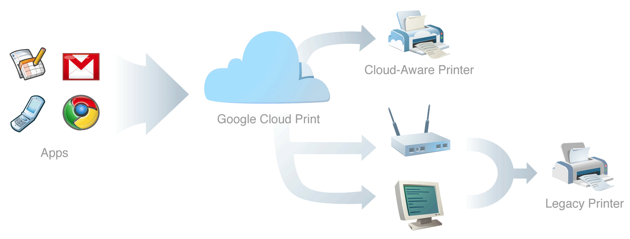 Google’s Chrome OS is due to come out some time this year, and there are still plenty of questions about how people are going to use a computer that’s based entirely in the browser. One question that came up when the OS was first announced: how are people going to print from this thing? Google has just spelled out its solution on the Chromium Blog: The Cloud.
Google’s Chrome OS is due to come out some time this year, and there are still plenty of questions about how people are going to use a computer that’s based entirely in the browser. One question that came up when the OS was first announced: how are people going to print from this thing? Google has just spelled out its solution on the Chromium Blog: The Cloud.
Google has announced a new project called Google Cloud Print which is setting out to “build a printing experience that enables any app (web, desktop, or mobile) on any device to print to any printer anywhere in the world.” In short, your computer or device will tell Cloud Print what it wants printed, and Cloud Print will then send the appropriate instructions to your printer. No printer drivers necessary.
Google is providing some initial documentation on the project here. The site says that any application, be it native or web based, will be able to use Cloud Print through APIs (which will allow you to submit print jobs and also check job status). There’s going to be a standard ‘web UI’ print dialog for interacting with the service from an application.
Of course, there’s still one big problem: getting Google Cloud Print to actually talk to your printer. Google has two solutions to this. In the long term, it is proposing that the industry adopt new open standards around cloud printing, and that manufacturers build new printer models to be ‘cloud aware’. In other words, the printer is connected to the web and includes software that knows how to communicate with Google’s servers.
The second solution is for ‘legacy printers’ (which include all printers at this point—even printers with an ethernet or Wifi connection). For these, Google plans to offer software that you install on the PC that the printer is connected to. Google is currently building this proxy software for Windows and intends to support Mac and Linux down the line. You won’t actually install the software on your own, either — it will come with Google Chrome (though it will be off by default). Google also hopes that some router manufacturers will start including the proxy software in their devices, so that users don’t have to leave their computers on.
A few key things to note: Google is going to offer its own Cloud Print service, but it wants the standard to be open and expects other alternative services to spring up as well. And this isn’t just for computers — it could potentially be used for phones, tablets, and any other web-enabled device. Wouldn’t that be nice.